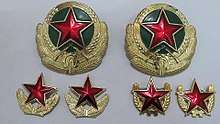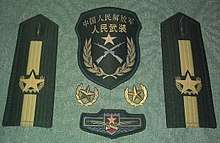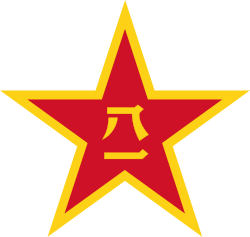Militia (China)
| Militia[1] China Militia 中国民兵 Zhōngguó Mínbīng | |
|---|---|
| Active | 1927 – present |
| Country |
|
| Allegiance |
|
| Branch |
Ground militia Maritime militia[3] |
| Type | Militia part of the armed forces of the People's Republic of China |
| Role |
Preparations against war; Defense operations; Assistance in maintaining public order (under the command of military organs which are all under the Central Military Commission)[1] |
| Size | 3 million |
| March | "March of the Militia" (《民兵进行曲》) |
| Engagements |
Chinese Civil War Sino-Japanese War Korean War Sino-Soviet border conflict (1969) Tiananmen Incident (1976) Sino-Vietnamese War (1979) Sino-Vietnamese conflicts (1979–90) South China Sea disputes[3] |
| Commanders | |
| Chairman of the Central Military Commission |
Xi Jinping (General Secretary & President) |
| Director of the National Defense Mobilization Commission |
Li Keqiang (Premier of the State Council) |
| Minister of National Defence | Gen. Wei Fenghe |
| Director of the CMC National Defense Mobilization Department | Lt. Gen. Sheng Bin |
| Insignia | |
| Old version of Cap badge and Emblem |
 |
| Newer version of Badges, Armband and Emblem |
 |
The Militia (Chinese: 民兵; pinyin: Mínbīng)[1] or China Militia (Chinese: 中国民兵; pinyin: Zhōngguó Mínbīng) is the militia part of the armed forces of the People's Republic of China, other two parts being the People's Liberation Army (PLA) and the People's Armed Police (PAP).[1] The Militia is under the leadership of the Communist Party of China (CPC)[2] and serves as an auxiliary and reserve force for the PLA.[4] It is one of the largest militias in the world.
History
The role of the militia has varied over the years. During the 1940s the militia served as a support force for PLA. After 1949 the party consolidated control over the country and used the militia to maintain Law and order in the country and for defense of the borders and coast. In the mid-1950s, Peng Dehuai attempted to build the militia as a reserve force. However, his efforts were thwarted, when the party expanded the militia, assigning it duties as an internal security force during the Great Leap Forward. Lin Biao reduced the size of the militia and reemphasized military training in the early 1960s. The militia was fragmented during the early years of the Cultural Revolution, but in the 1970s it was rebuilt to support the PLA. The Gang of Four also attempted to build up the urban militia as an alternative to the PLA, but the urban militia failed to support the Gang of Four, when Hua Guofeng and other moderate military leaders deposed them. The militia's logistical support of the PLA was essential during the Sino-Vietnamese War. In the 1980s, Chinese leaders improved the militia's capabilities by reducing its size and economic works.
Roles and tasks
According to Article 22 of the Law of the People's Republic of China on National Defence, the Militia, under the command of military organs, shoulders the tasks of preparations against war and defence operations, and assists in maintaining public order.[1]
According to Article 36 of the Military Service Law of the People's Republic of China, the Militia's tasks are:[4]
- take an active part in the socialist modernization drive and be exemplary in completing the tasks in production and other fields;
- undertake the duties related to preparations against war, defend the frontiers and maintain public order; and
- be always ready to join the armed forces to take part in war, resist aggression and defend the motherland.
Maritime Militia
China Maritime Militia (CMM) is a subset of China’s national militia. The CMM trains with and supports the People's Liberation Army Navy and the China Coast Guard in tasks including[3]
- safeguarding maritime claims
- protecting fisheries
- logistics
- search and rescue (SAR)
- surveillance and reconnaissance
In the South China Sea, the CMM plays a major role in maritime activities to achieve China’s political goals without fighting.[3]
See also
References
- 1 2 3 4 5 Law of the People's Republic of China on National Defence, Article 22: "The armed forces of the People’s Republic of China are composed of the active and reserve forces of the Chinese People's Liberation Army, the Chinese People's Armed Police Force and the Militia. ...... The Militia, under the command of military organs, shoulders the tasks of preparations against war and defence operations and assists in maintaining public order."
- 1 2 Regulation on Militia Work (2011 Revision), Article 2: "The militia is an armed organization composed of the people not released from their regular work under the leadership of the Communist Party of China (CPC), is a part of the armed forces of the People's Republic of China and is an assistant and reserve force for the Chinese People's Liberation Army."
- 1 2 3 4 Military and Security Developments Involving the People’s Republic of China 2017 by the Office of the Secretary of Defense, United States Department of Defense
- 1 2 Military Service Law of the People's Republic of China, Chapter VI The Militia, Article 36: "The militia is an armed organization of the masses not divorced from production and is an assisting and reserve force for the Chinese People's Liberation Army. The tasks of the militia are: ......"
External links
- Official (People's Republic of China)
- The Militia, China’s National Defense in 2002 (whitepaper) by the State Council Information Office
- The Components of the Armed Forces, China Internet Information Center
- Other
- The Militia globalsecurity.org
.svg.png)
